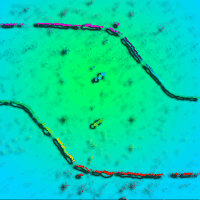
Richness and abundance of granivorous vertebrates determine acorn removal patterns in a human modified oak forest
Felipe Barragán (1) , Ernesto I Badano (2), David Douterlungne (1), Joel Flores (2)
iForest - Biogeosciences and Forestry, Volume 11, Issue 2, Pages 329-337 (2018)
doi: https://doi.org/10.3832/ifor2216-011
Published: Apr 18, 2018 - Copyright © 2018 SISEF
Research Articles
Abstract
Most forests of the Earth have been affected by human activities and this can alter the plant-animal interactions on which depend the functional integrity of these ecosystems. In this study, we assessed the relationships between acorn removal rates and the richness and abundance of granivorous vertebrates along a forest-edge-clearing gradient. We also evaluated whether removal rates differed among oak species with different acorn size. To this purpose, a field experiment was performed including acorns of five oak species, which were exposed to seed consumers in the three different habitats (forest interior, man-made clearings and the edge between these habitats). The experimental units consisted in five paper trays containing 50 acorns of each oak species located at different distances from the edge towards the forest and the man-made clearing (0, 20 and 50 m). Experimental sites were equipped with phototraps to record the identity of the visiting granivorous vertebrates. Richness and abundance of granivores increased from the edge towards the forest interior, while the converse patterns were observed in the man-made clearing. For most oak species, acorn removal patterns was positively correlated with richness and abundances of granivores, though in all habitats small-sized acorns were removed much faster and in larger proportions than big-sized acorns. Although these results are specific for the study site, they suggest that man-made clearings reduce the richness and abundance of granivores, thus negatively affecting the secondary dispersion of zoochoric tree species towards open habitats. Further, it also seems that large-seeded oak species face greater dispersal limitations than small-seeded oaks, because of the lack of animals able to scatter them from the forest to the clearings.
Keywords
Acorn Size, Forest Gaps, Land Use Change, Man-made Clearing, Species Diversity
Authors’ Info
Authors’ address
David Douterlungne
CONACYT-IPICYT, División de Ciencias Ambientales, Instituto Potosino de Investigación Científica y Tecnológica, Camino a la Presa San José 2055, Lomas 4ª Sección, C.P. 78216, San Luis Potosí, SLP (México)
Joel Flores
IPICYT-División de Ciencias Ambientales, Instituto Potosino de Investigación Científica y Tecnológica, Camino a la Presa San José 2055, Lomas 4ª Sección, C.P. 78216, San Luis Potosí, SLP (México)
Corresponding author
Paper Info
Citation
Barragán F, Badano EI, Douterlungne D, Flores J (2018). Richness and abundance of granivorous vertebrates determine acorn removal patterns in a human modified oak forest. iForest 11: 329-337. - doi: 10.3832/ifor2216-011
Academic Editor
Gianfranco Minotta
Paper history
Received: Sep 05, 2016
Accepted: Jan 21, 2018
First online: Apr 18, 2018
Publication Date: Apr 30, 2018
Publication Time: 2.90 months
Copyright Information
© SISEF - The Italian Society of Silviculture and Forest Ecology 2018
Open Access
This article is distributed under the terms of the Creative Commons Attribution-Non Commercial 4.0 International (https://creativecommons.org/licenses/by-nc/4.0/), which permits unrestricted use, distribution, and reproduction in any medium, provided you give appropriate credit to the original author(s) and the source, provide a link to the Creative Commons license, and indicate if changes were made.
Web Metrics
Breakdown by View Type
Article Usage
Total Article Views: 46552
(from publication date up to now)
Breakdown by View Type
HTML Page Views: 39922
Abstract Page Views: 2936
PDF Downloads: 2707
Citation/Reference Downloads: 17
XML Downloads: 970
Web Metrics
Days since publication: 2790
Overall contacts: 46552
Avg. contacts per week: 116.80
Citation Metrics
Article Citations
Article citations are based on data periodically collected from the Clarivate Web of Science web site
(last update: Mar 2025)
Total number of cites (since 2018): 3
Average cites per year: 0.38
Publication Metrics
by Dimensions ©
Articles citing this article
List of the papers citing this article based on CrossRef Cited-by.
References
Historia natural, domesticación y distribución del guajolote (Meleagris gallopavo) en México [Natural history, domestication and distribution of the turkey (Meleagris gallopavo) in Mexico]. Universidad y Ciencias 27: 351-360. [in Spanish with English summary]
Gscholar
Global forest resources assessment. Food and Agriculture Organization of the United Nations, Rome, Italy, pp. 340.
Gscholar
Modificaciones al sistema de clasificacion climatica de Koppen [Modifications to the Köppen climate classification system] (5th edn). Universidad Nacional Autóma de México, México City, pp. 91. [in Spanish]
Gscholar
Nutritional value of acorns for wildlife. In: “Oak Forest Ecosystems: Ecology and Management for Wildlife” (McShea WJ, Healy WM eds). Johns Hopkins University Press, Baltimore, USA, pp. 173-181.
Gscholar
Los encinos de México [Oaks of Mexico] (2nd edn). Comisión Forestal del Estado de Michoacán, Morelia, México, pp. 358. [in Spanish]
Gscholar
Composición de la dieta del guajolote silvestre (Meleagris gallopavo mexicana, Gould, 1856) reintroducido en Sierra Fría, Aguascalientes, México [Diet composition of reintroduced wild turkey (Meleagris gallopavo mexicana, Gould, 1856) in Sierra Fria, Aguascalientes, Mexico]. Veterinaria México 36: 395-409. [in Spanish with English summary]
Gscholar
The genus Quercus in México. In: “Biological Diversity of Mexico: Origins and Distribution” (Ramamoorthy TP, Bye R, Lot A, Fa J eds). Oxford University Press, New York, USA, pp. 447-548.
Gscholar
Acorn dispersal by birds and mammals. In: “Oak Forest Ecosystems: Ecology and Management for Wildlife” (McShea WJ, Healy WM eds). Johns Hopkins University Press, Baltimore, USA, pp. 182-195.
Gscholar
Turkey, acorns and oaks. In: “Oak Forest Ecosystems: Ecology and Management for Wildlife” (McShea WJ, Healy WM eds). Johns Hopkins University Press, Baltimore, USA, pp. 241-255.
Gscholar
Introducción a la ecología de la regeneración natural de encinos [Introduction to the ecology of the natural regeneration of oaks]. Universidad Autónoma Chapingo, Texcoco, México, pp. 94. [in Spanish]
Gscholar

















